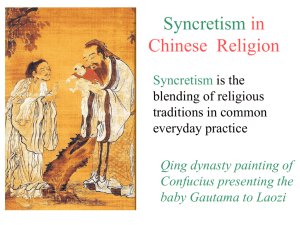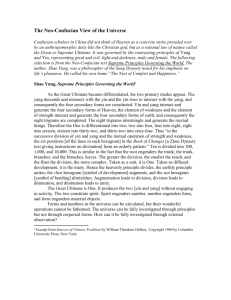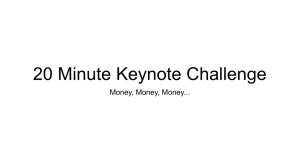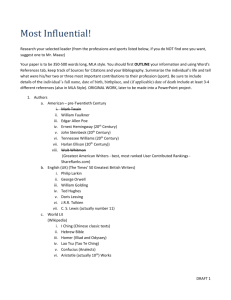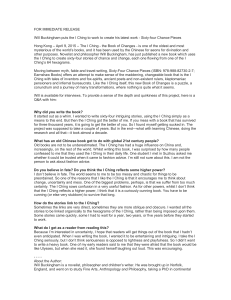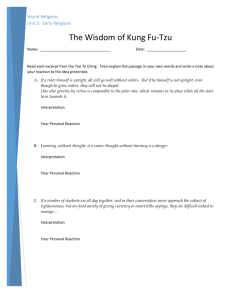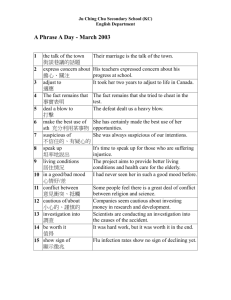Reading_The_I
advertisement
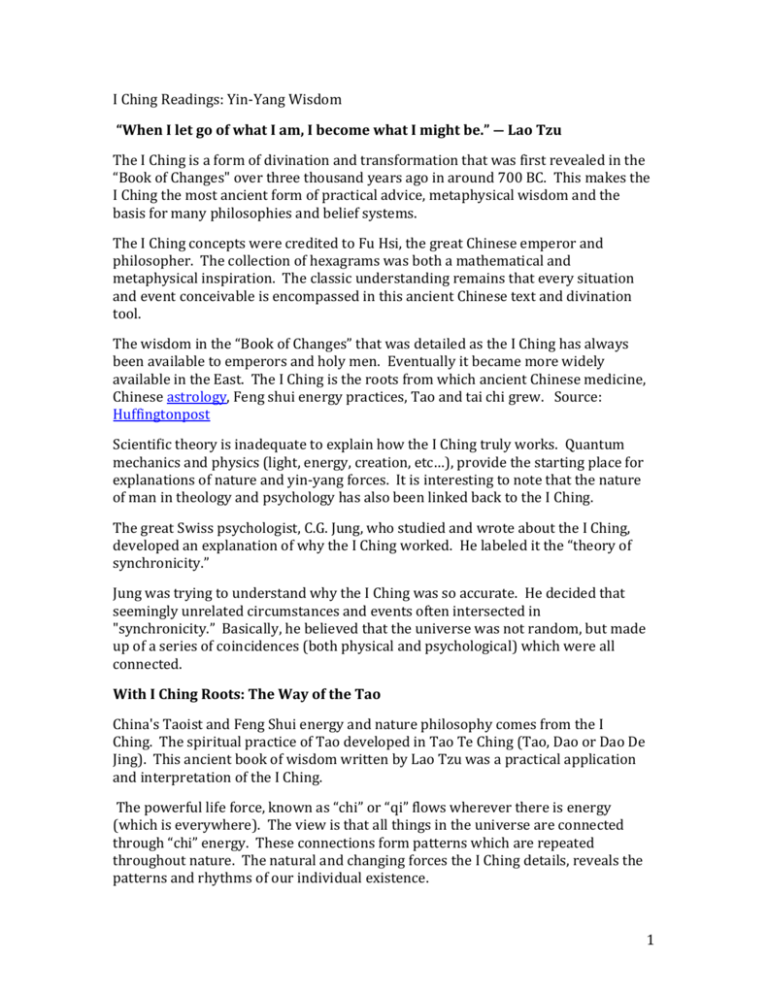
I Ching Readings: Yin-Yang Wisdom “When I let go of what I am, I become what I might be.” ― Lao Tzu The I Ching is a form of divination and transformation that was first revealed in the “Book of Changes" over three thousand years ago in around 700 BC. This makes the I Ching the most ancient form of practical advice, metaphysical wisdom and the basis for many philosophies and belief systems. The I Ching concepts were credited to Fu Hsi, the great Chinese emperor and philosopher. The collection of hexagrams was both a mathematical and metaphysical inspiration. The classic understanding remains that every situation and event conceivable is encompassed in this ancient Chinese text and divination tool. The wisdom in the “Book of Changes” that was detailed as the I Ching has always been available to emperors and holy men. Eventually it became more widely available in the East. The I Ching is the roots from which ancient Chinese medicine, Chinese astrology, Feng shui energy practices, Tao and tai chi grew. Source: Huffingtonpost Scientific theory is inadequate to explain how the I Ching truly works. Quantum mechanics and physics (light, energy, creation, etc…), provide the starting place for explanations of nature and yin-yang forces. It is interesting to note that the nature of man in theology and psychology has also been linked back to the I Ching. The great Swiss psychologist, C.G. Jung, who studied and wrote about the I Ching, developed an explanation of why the I Ching worked. He labeled it the “theory of synchronicity.” Jung was trying to understand why the I Ching was so accurate. He decided that seemingly unrelated circumstances and events often intersected in "synchronicity.” Basically, he believed that the universe was not random, but made up of a series of coincidences (both physical and psychological) which were all connected. With I Ching Roots: The Way of the Tao China's Taoist and Feng Shui energy and nature philosophy comes from the I Ching. The spiritual practice of Tao developed in Tao Te Ching (Tao, Dao or Dao De Jing). This ancient book of wisdom written by Lao Tzu was a practical application and interpretation of the I Ching. The powerful life force, known as “chi” or “qi” flows wherever there is energy (which is everywhere). The view is that all things in the universe are connected through “chi” energy. These connections form patterns which are repeated throughout nature. The natural and changing forces the I Ching details, reveals the patterns and rhythms of our individual existence. 1 Chinese philosophy holds that the flow of “chi” comes from the interaction of the two primary opposing universal forces Yin and Yang. Both forms of energy are necessary for life to exist and Chinese philosophers consider the flow of nature and life to be the constant balancing of the yin and yang energies. The Foundation of the I Ching: Yin and Yang Polarity Source: Tionghoa Yin and Yang is one of the most fundamental concepts of the I Ching. The earliest reference to Yin and Yang is in the I Ching (Book of Changes). In this work, all phenomena and circumstances are based on the foundation of Yin-Yang. In the classic sense "Yin creates Yang and Yang activates Yin”, these energies are the heart of nature and the soul of humanity. Yin and Yang are polar opposites, yet they are interdependent. Yin Yang, as outlined in I Ching, is the basic underpinning and the vital theory behind Traditional Chinese Medicine (TCM) diagnosis, treatment and physiology. It is also the guiding principal for Chinese astrology and the Chinese calendar. The Yin-Yang principle is after all, the active force of nature, creation and all spiritual energy. This is the premise that there is the earth and the heavens with humanity in-between. 2 There are four distinct stages of Yin and Yang. They are Wei, qi, ying and xue. There are eight distinct trigrams (Ba Gua). A Trigram is called 'Gua', and the number eight translates as 'Ba'. The number 8 is also the infinity sign. When multiplied (8×8), the result is the number 64. There are 64 trigrams which symbolize every possibility in nature and humanity. Traditionally the I Ching practitioner would arrange the Ba Gua in a circle using the Taiji symbol of Yin-Yang at the center. This symbolizes the circle of life and cycle of all nature’s changes within the context of the Yin-Yang duality All Things Yin and Yang (Ba Gua) form the 64 hexagrams, which encompass all circumstances of the Universe. The I Ching reading consists of the interpretation of these 64 hexagrams. Each hexagram is made up of dual trigrams. There are eight trigrams which are created by the various yin and yang combinations. The top trigram represents what is happening in the heavens and the bottom trigram represents what is happening in the physical world. I Ching Readings If you are trying to divine, the wisdom of the I Ching you will need a book which you can refer back to that interprets all 64 hexagrams. You will also need 50 yarrow straws or 3 coins to toss. The I Ching reader must also have something to write with (pen and paper). The I Ching was traditionally interpreted through a complicated process of throwing 50 yarrow stalks. This still may be the most accurate way to read the I Ching. In modern times, the use of coins, cards, colored marbles and even digital online tools has become popular. A set of three coins Chinese coins are often used. The coins are thrown six times. The seeker must keep the question in mind while this process takes place. As with any form of divination, the person who seeks answers (the seeker) must hold the question in their mind. Often times a qualified practitioner will be able to read the I Ching for the seeker. The practitioner may be better able to keep a clear focus. The seeker is required to relax and not allow the intrusion of other thoughts, fears and worries. It is best to keep concentration on the question or problem at hand throughout the reading. Only one question or issue can be given at a time. There are a variety of ways to consult the I Ching. Keep in mind that the reader of the I Ching must first develop the hexagram through tossing the yarrow sticks or coins. Each hexagram is then read or interpreted from the bottom up. 3 When consulting the I Ching with coins take the coin in your left hand. Ask your question out loud while tossing the coin. It can fall onto a table or the ground. Hexagrams are in reality, six line sets. Each line represents the changes in our lives. They can be broken lines _ _ or unbroken lines ___. The yin lines are broken. The yang lines are unbroken. Yin is female energy (passive, solid, dark, earthy). Yang is male energy (active, interrupted, light, other worldly). Traditionally "heads" is considered yang and "tails" yin. If your toss produces a solid line (yang), draw an unbroken line on a piece of paper. If your toss produces interrupted line (yin) then draw a broken line. This line forms the hexagram base. Additional lines will be drawn one above the other. Repeat this process 5 more times. You should now have a total of 6 lines. Don’t get distracted. Maintain your focus on the question. The last line you draw should be the very top one. The six lines you now have represent the hexagram that will answer your specific question. Again, there are 64 hexagrams made up of unique 6 line configurations. Your hexagram will look like one of these below. Source: Shiftoftheage Your reading will now proceed. You may ask additional questions later. First, take a look at the nuanced meanings of your hexagram. This oracle will define your current situation. It will show you what is to come. But most importantly, the I Ching will let us know what energy we need to use to get the best result in future outcomes. This is a predictor that both clarifies the present and focuses your direction on how to react to the ever changing future. Using the wisdom of the I Ching, we can take our own energy and shift the direction of our life. In the I Ching, our future is not set in concrete. Each of us has the infinite power of our energy to work with in order to change the future. So when we throw the coins (or yarrow sticks) we are acknowledging that change is the only constant and people are capable of moving in powerful ways towards the positive. This ancient and all-encompassing soul reader will surprise you. The "random" questions that any seeker asks may have answers as old as tim 4
